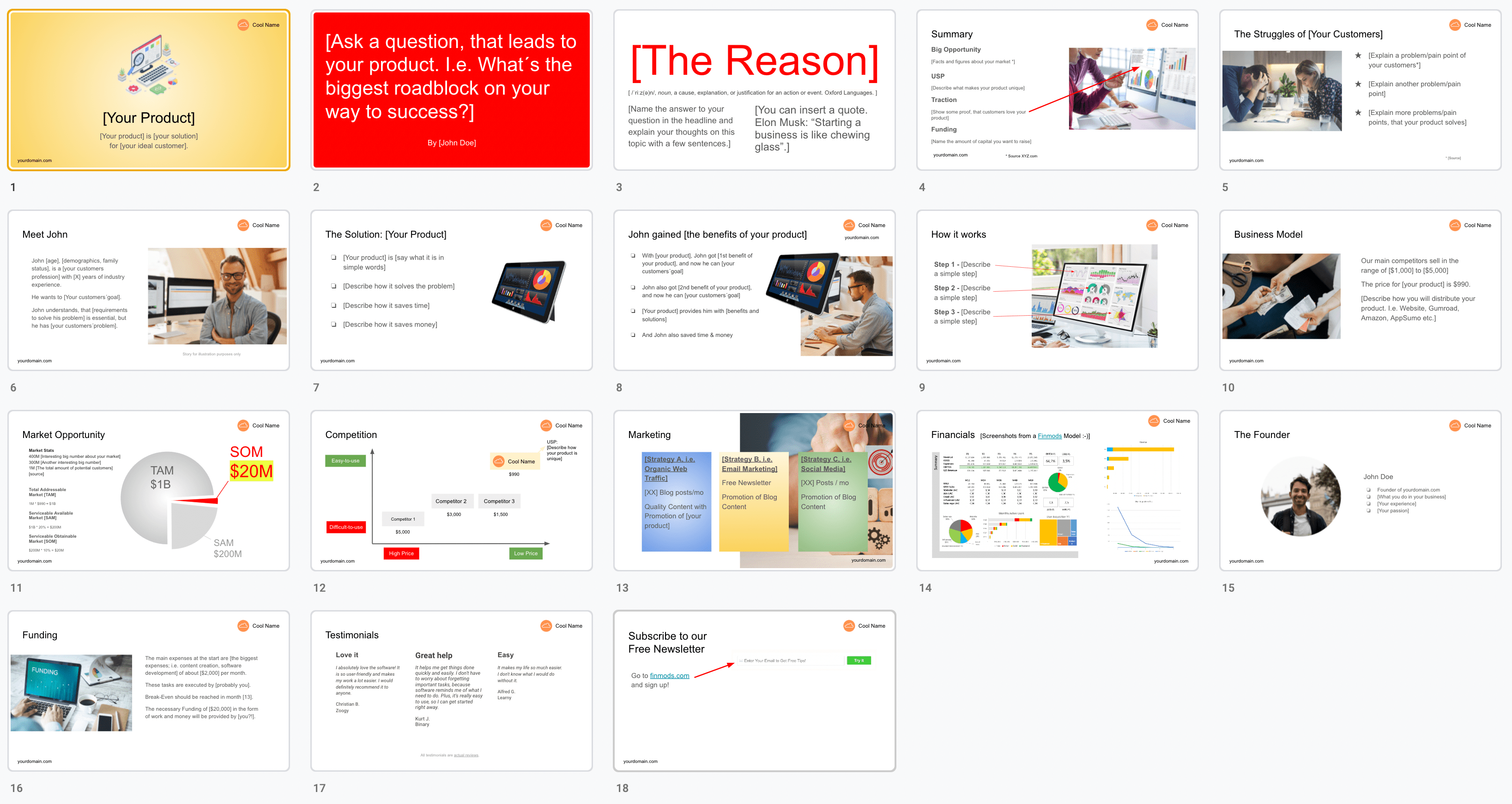A pitch deck is a slide presentation used by a startup or small business to pitch its business to investors. The presentation typically includes information about the company, its products or services, and financials. Pitch decks present business ideas to potential customers or partners.
Some people recommend having 10-15 slides in a pitch deck, while others recommend having 20 or more slides. The most important thing is to make sure that your pitch deck is concise and easy to follow to effectively communicate your idea. So, let´s get right into it!
Why does any Founder, even the Side Hustle Solopreneur, need a Pitch Deck and a Financial Plan?
Motivation!
Maybe you thought having a written plan is essential to raise capital and get clear about prices and costs. This is all correct, and there are many good answers. But if the founder of a startup lacks motivation, the business is destined to die.
Elon Musk said: “Starting a business is like chewing glass”. That’s certainly true, and therefore it’s guaranteed that any founder will run into obstacles that try to throw him off course.
In such moments it is priceless to have a business plan that records the most important goals and measures. You need a pitch deck to pitch yourself when you start a business. This helps to stay on track.
And reading your plan can also be a source of motivation as you read your own success story that you are writing right now.
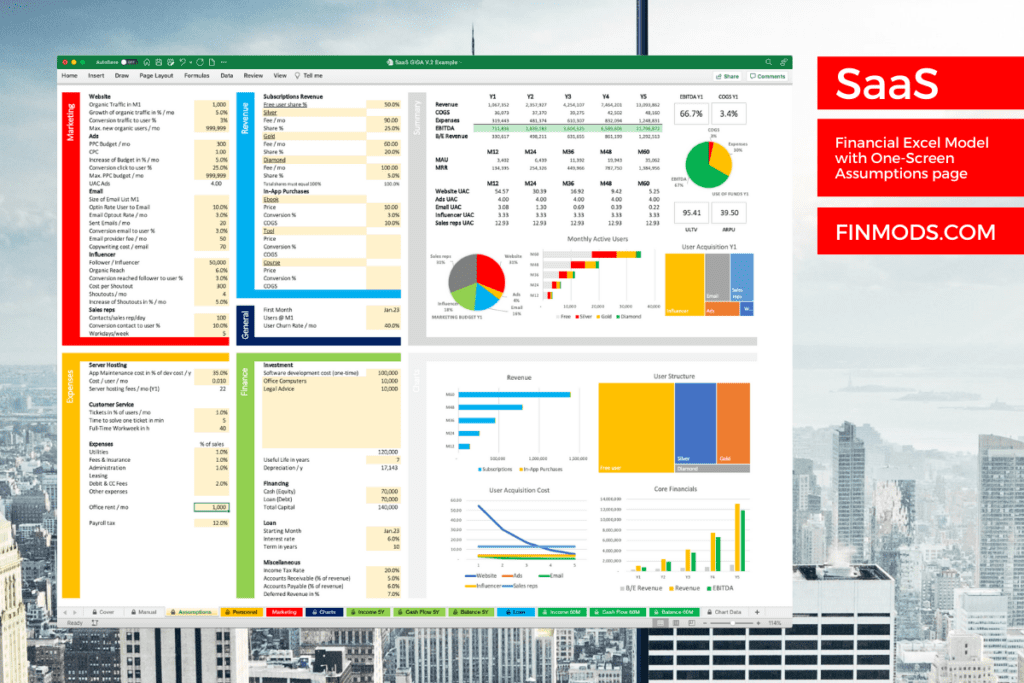
The Structure of a Compelling Pitch Deck
The Cover
The cover of your pitch deck is one of the most critical pieces. It should be eye-catching and convey your big idea. In addition, the cover should be simple and easy to understand.
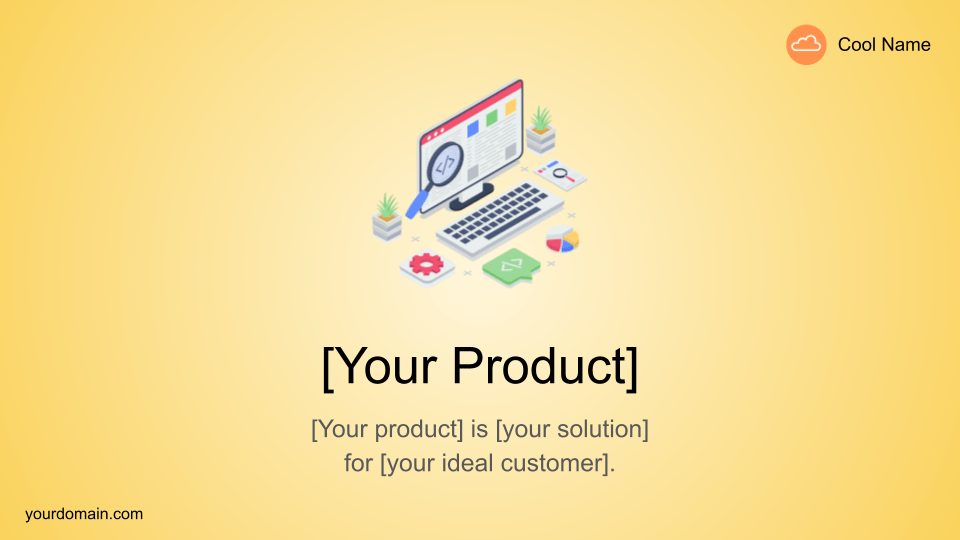
Ask an Engaging Question
The benefits of an engaging question are that it can help stimulate cognitive activity, focus attention, and promote the exchange of ideas. Additionally, questions can help to clarify information and assess understanding.

Introduce a Leading Thought
There are a few potential benefits to having a leading thought. First, it can help you focus on what you want to achieve. When you have a specific goal in mind, it can be easier to stay on track and progress. Additionally, having a leading thought can help keep your audience motivated. When you’re working towards something important to you, it’s easier to push through challenges and setbacks.
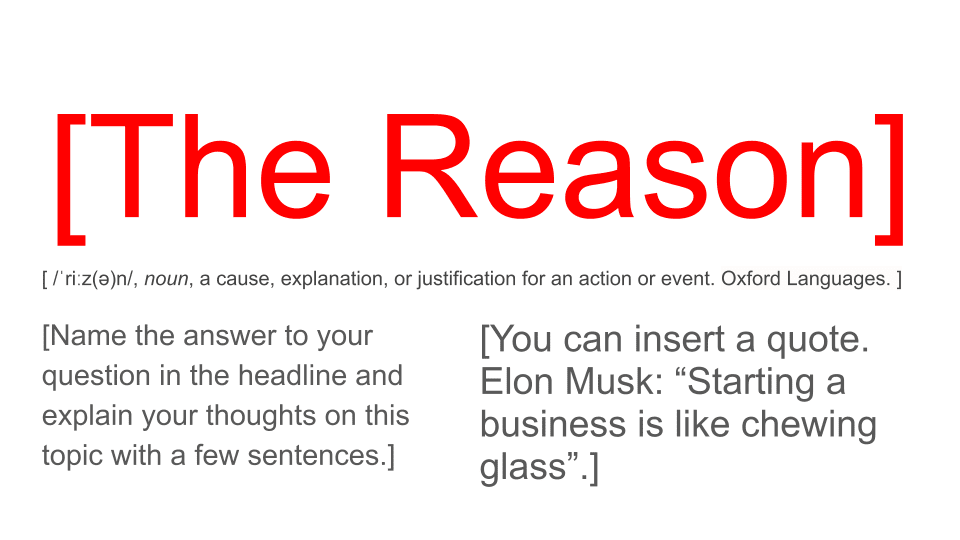
Summary
The summary of a pitch deck should include information about the enormous opportunity that the company is pursuing, the company’s unique selling proposition, and the amount of traction that the company has been able to generate so far. It is also essential to discuss the company’s funding needs and how you will use the invested funds.
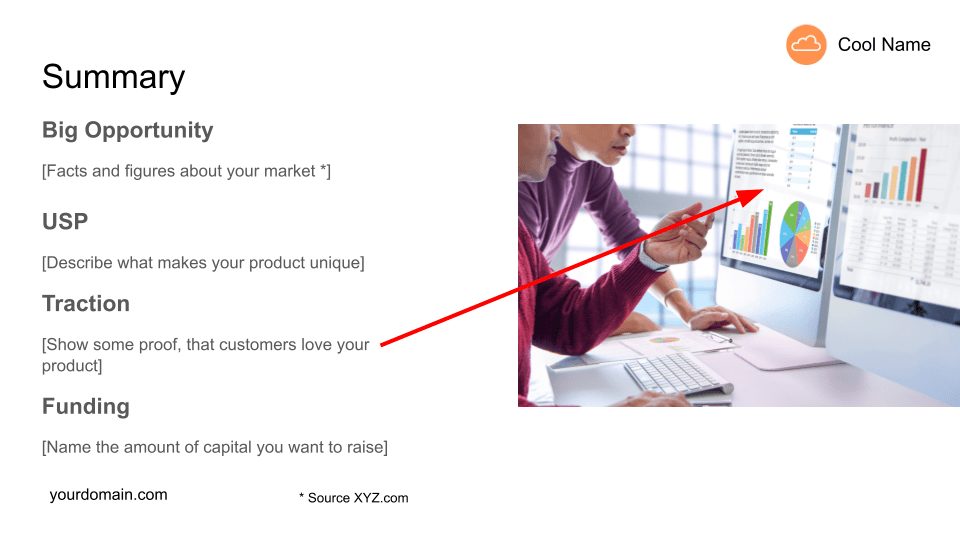
The Problem
The customer problem is essential in a pitch deck because it helps investors understand the market opportunity and how the company plans to address it. The customer problem should be explained in detail so that investors can understand the company’s competitive landscape and how it intends to differentiate itself. Additionally, defining the customer problem helps investors understand the company’s target market and how it plans to reach them. Explain who your customers are, what the problem is, and why they are frustrated.
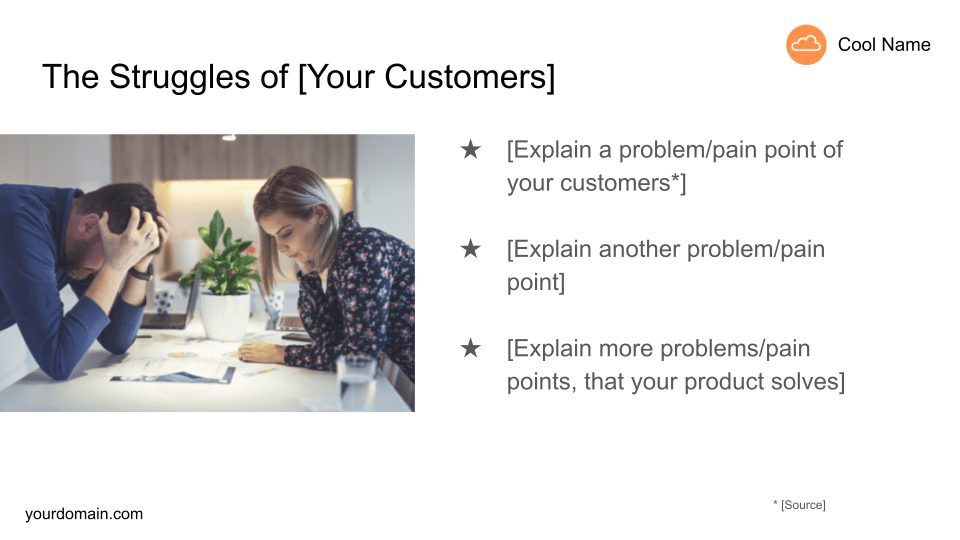
Customer Story 1/2
The benefits of telling customer stories in a pitch deck include establishing trust with the audience, building a relationship, and helping the reader understand the business. Telling customer stories also demonstrates that the company has a marketable product or service and already a demand for it. Finally, stories about your customer avatar can help the investor understand how the company plans to scale and how it will make money.
A customer avatar is a description of your ideal customer. This should include information about their demographics (age, gender, location, etc.) and their interests and needs. It’s essential to have a clear picture of your avatar to target your marketing efforts effectively. You can use your avatar to explain who you’re targeting and why they’re a good fit for your product or service in a pitch deck.

The Solution
Describe the solution in a straightforward and easy to understand way and provide answers to the following questions:
- What is the solution?
- How is your solution better?
- What are the benefits?
- What makes it unique?

Customer Story 2/2
Now it’s time to show how your customer avatar benefits from your solution. Explain which specific benefits your customer avatar gets by using your product.

How the product works
Show three simple steps and how the customer uses the product. Insert a picture of your product and let arrows point to appropriate areas in the image.
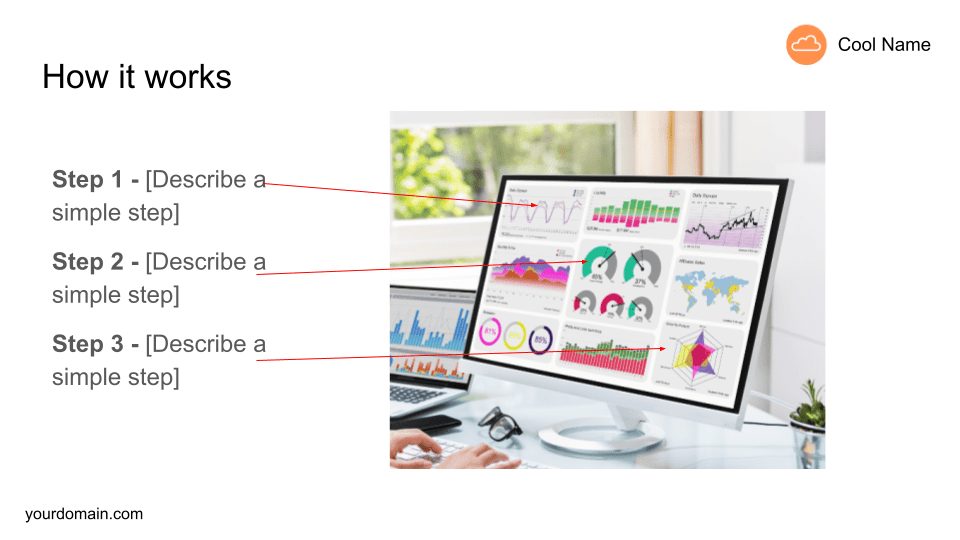
The Business Model
A startup’s business model is how it creates value for its customers. It’s how you make money. In your pitch deck, describe your business model, your price, and the price range of your main competitors. Further, you can explain distribution, i.e. your website, a service like Gumroad, a platform like AppSumo, or a marketplace like Amazon.
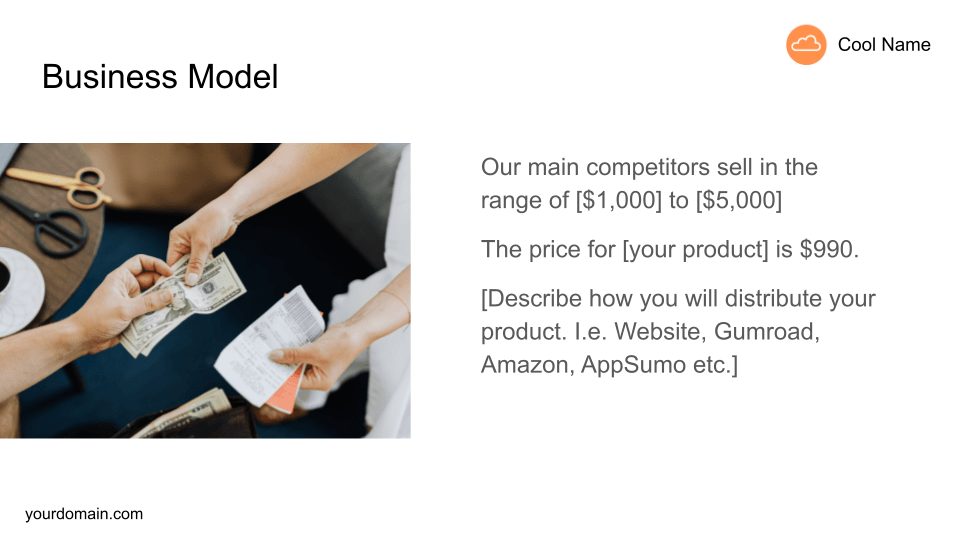
Not sure which business model is best for you? Then check out the following popular business models:
- Recurring revenue is a revenue stream that comes in fixed, predetermined intervals. For example, a subscription-based business model would generate recurring revenue each month from its customers. This type of revenue is attractive to businesses because it provides a predictable source of income, which can be helpful when planning for the future.
- A subscription business model is a business model in which a company charges its customers repeatedly for access to its products or services. Companies often use this type of business model that offers subscription-based content, such as software, newspapers, magazines, and online streaming services.
- In-app purchases are a business model in which users can purchase digital goods or services from within an app. This business model is often used to monetize free apps, as it allows developers to earn revenue from users who wouldn’t otherwise pay for the app. In-app purchases can be used to purchase anything from additional features or content to virtual currency or items used within the app.
- The One-time fee business model is often used for products or services that are not recurring, such as an online course or a software program. One-time fees can be a good way for companies to make money up-front on products or services that have a high cost to produce or are not recurring.
- The transaction fee percentage business model charges a set percentage of each transaction to provide the service. Companies often use this type of business model is often used by companies that offer a platform or marketplace for buyers and sellers to interact. The fee helps the company cover the costs of running the service and making a profit.
- The advertising business model is a system in which businesses use various forms of advertising to promote their products or services. Typically, the advertiser pays the media outlet (e.g., television network, radio station, website, etc.) for the right to air its commercial. The media outlet then sells advertising space or time to the advertiser.
- An affiliate business model is a type of business model where a company rewards affiliates for each customer or visitor that they refer to the company’s website. The affiliate business model is often used in online marketing, where affiliates are rewarded for sending traffic to a company’s website. In the affiliate business model, the company pays the affiliate a commission for each customer or visitor that they refer. This commission can be a fixed amount, or it can be a percentage of the sale price.
- Benefits of active streams: For businesses, active streams like subscriptions and fees provide a predictable, recurring revenue stream that can help fund operations and growth. They can also help companies to build a loyal customer base by delivering value to customers. For customers, active income streams provide a way to access high-quality services or products at a lower cost than buying them outright. They can also offer a way to support businesses they believe in.
- Benefits of passive streams: Passive income streams like ads and affiliate commissions provide several benefits for businesses. First, they provide a consistent stream of revenue that can be relied on to help cover costs and grow the business. Second, they are relatively low-maintenance, requiring only a small up-front investment and minimal ongoing effort. This allows companies to focus on their core operations and grow more efficiently.
Market Opportunity
The market opportunity for a new product is the market’s potential size, and how much of that market can be captured. The market size is determined by the number of potential customers and their needs. The potential for a new product is also affected by how well it meets customer needs, how well it is marketed, and how much it costs.
- Total Addressable Market (TAM): All customers, that could buy your product.
- Serviceable Addressable Market (SAM): All customers, that are likely to buy your product; a subset of TAM.
- Serviceable Obtainable Market (SOM): The realistic market share, that includes all customers, that you can reasonably acquire within the next 3-5 years; a subset of SAM.
Your pitch deck should include big round numbers for TAM, SAM, and SOM, that make sense.
Example for financial models for tech startups worldwide:
- TAM (could buy): 1.35M * $150 ≈ $200M
- SAM (likely to buy): $200M * 20% = $40M
- SOM (reasonable market share in 3-5y): 10-20% of SAM, $40M * 10% = $4M
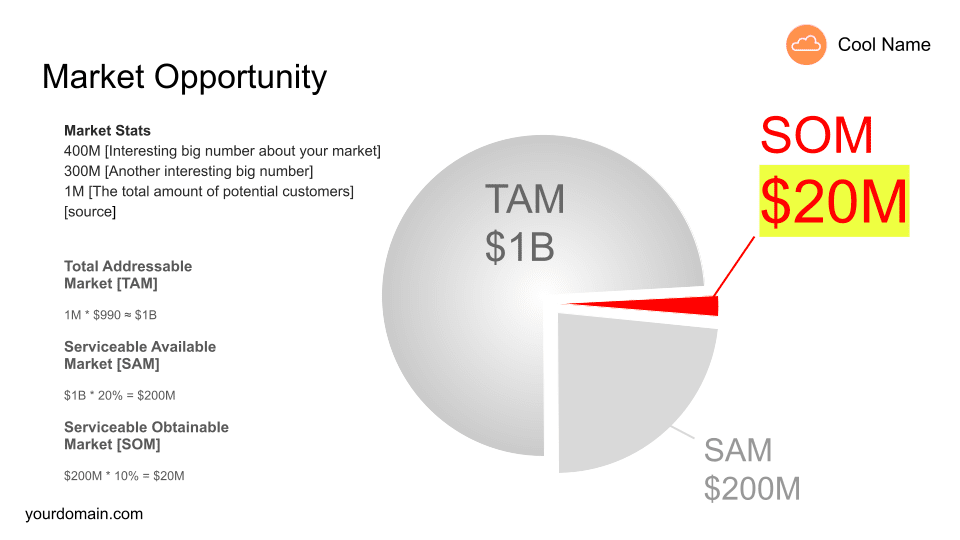
Competition
The competition analysis should demonstrate how you differentiate your product to attract customers. Identify two or three main competitors and determine two options, that are essential to customers. i.e. Ease of use and price.
Option 1 – The Matrix: Draw a 2×2 matrix and position your competitor’s products and your product. The reasonable outcome should be that your product is superior to the competition and appears in the upper right quadrant.
Option 2 – The List: Create a list of features and benefits important to your customers and compare your product with the competition. Your product should be the only one that checks all boxes.
In any case, you should stress how your product is unique and superior.
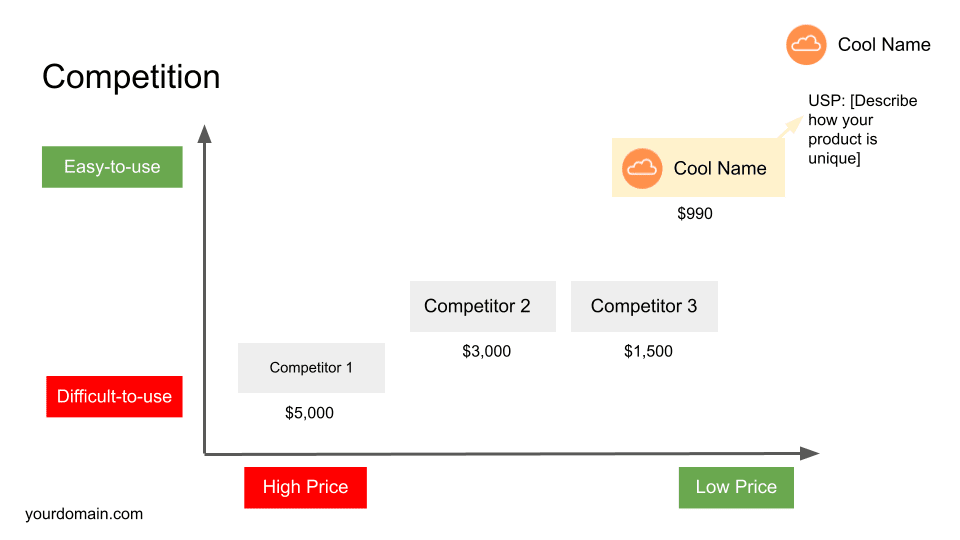
Marketing
Your marketing slide should state how you will grow your business and get customers. Popular online strategies are:
- Organic Traffic through blog articles, keyword research, and SEO: You write content and publish it on your blog, your customers search on Google and find your website, and finally, some buy your product.
- Email Marketing (Newsletter, Cold Emails) has many benefits for businesses. It is a cost-effective way to reach many people, and it allows businesses to target their advertising specifically to those who are most likely to be interested in their products or services. Email marketing also helps companies keep track of customer preferences and behaviors, which can help improve the effectiveness of future marketing campaigns. Additionally, email marketing allows businesses to build relationships with customers over time, leading to increased sales and loyalty.
- YouTube marketing is an essential part of any successful online marketing strategy. By creating interesting and engaging videos, businesses can attract new customers and keep them engaged. Videos can also create brand awareness and drive traffic to websites. In addition, videos can be used to generate leads and sales.
- Social media marketing has a variety of benefits for businesses. It allows companies to reach a large number of people quickly and easily, and it also allows businesses to build relationships with customers and create a community around their brand. Additionally, social media marketing is a cost-effective way to promote your business, and it can also help you track how well your marketing campaigns are performing.
- Be cautious when using paid ads. It’s easy to waste a lot of money this way, and you may end up paying more for clicks than you earn in revenue. If you’re not careful, you can quickly burn through your advertising budget without seeing any actual results. Before investing in paid ads, do your research and understand the risks involved. Make sure you have a solid plan for how you’ll measure success and know when to pull the plug if things aren’t going well.
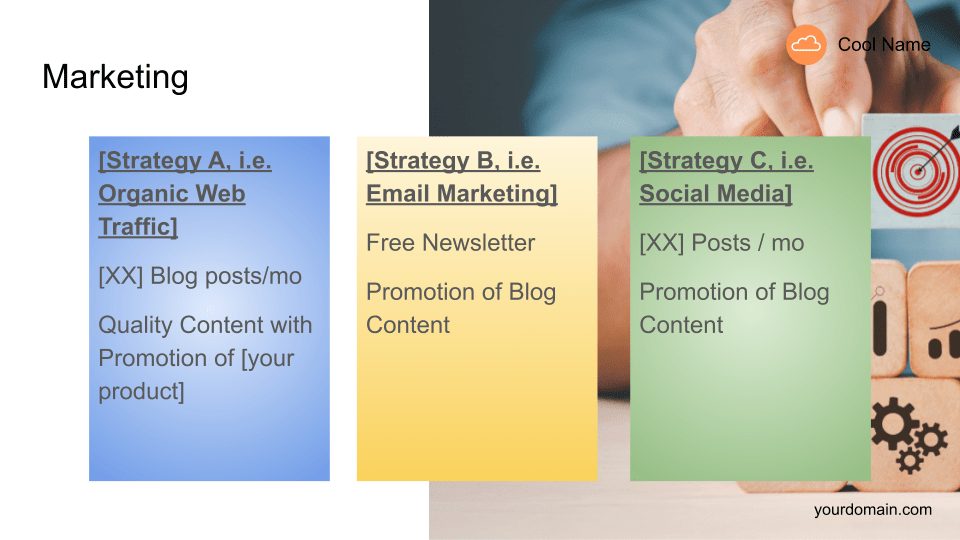
Key Performance Metrics:
- Customer acquisition cost (CAC) is the total cost incurred by a company to acquire a new customer. This includes advertising and marketing expenses and the cost of any incentives offered to customers. CAC is an important metric for companies as it helps them determine how much they need to spend to attract new customers.
- Lifetime value (LTV) is a measure of the profitability of a customer over the entire period of their relationship with a company. It considers all revenue and profit generated from a customer, from the time they first become a customer until they leave or are lost. This makes it a valuable tool for businesses, as it can help them make decisions about how best to attract and retain customers.
- Profitable Marketing: To be profitable, a business must have a low customer acquisition cost (CAC) and a high lifetime value (LTV). You should aim to reach an LTV that is 3-5X your CAC. Achieving a low CAC requires creating a strong marketing strategy that attracts customers who are likely to become long-term customers. This can be done by targeting the right audience, using effective marketing channels, and creating engaging content that resonates with potential customers. Once you’ve acquired customers, it’s important to focus on retaining them by providing great customer service and offering valuable products and services. By keeping your CAC low and your LTV high, you can ensure that your business is profitable and sustainable.
Financials
The financials in your pitch deck are your best guess of future revenue and expenses for the next three to five years. At least include an income statement with a few meaningful charts in your pitch deck. When building your financial model, also check to have a positive cash balance every month. A negative cash balance means that your business is bankrupt.

There are three different financial statements: The income statement, the cash-flow statement, and the balance statement.
- An income statement is a financial statement that shows a company’s financial performance over a specific period of time. The income statement includes revenue, expenses, and net income. Revenue is the money a company earns from its normal business activities. Expenses are the costs of doing business, such as salaries, rent, and supplies. Finally, net income is the amount of money a company earns after subtracting its expenses from its revenue.
- The cash flow statement is a financial statement that shows how much cash a company has generated and used during a specific period. This statement can track a company’s cash flow over time or compare two different periods. The cash flow statement is divided into operating activities, investing activities, and financing activities.
- A balance statement is a financial statement that shows the balances of a company’s assets, liabilities, and owner’s equity at a specific time. This statement is essential for investors and creditors because it shows how much money the company has available to pay its debts and how much money it owes. The balance statement is also used to track changes in a company’s financial position over time.
Team/Founder
Insert a nice profile picture and add details about your position, expertise, passion, and experience.
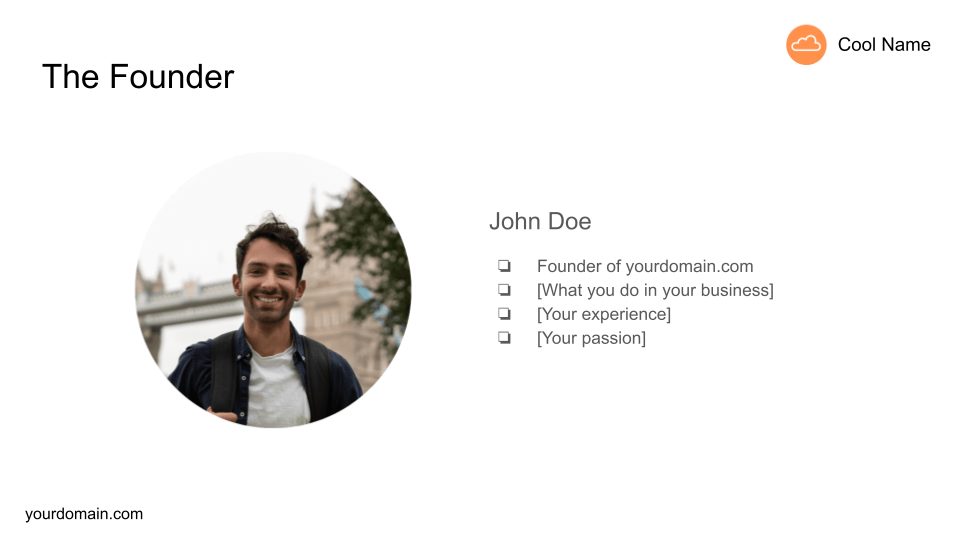
Funding
Your financial model should tell you how much money you have to invest until you reach break-even, the point of profitability. The funding slide should include:
- How much capital do you need to start?
- What are the main expenses?
- When do you plan to reach the break-even point?
- Who will fund your business with which amount?
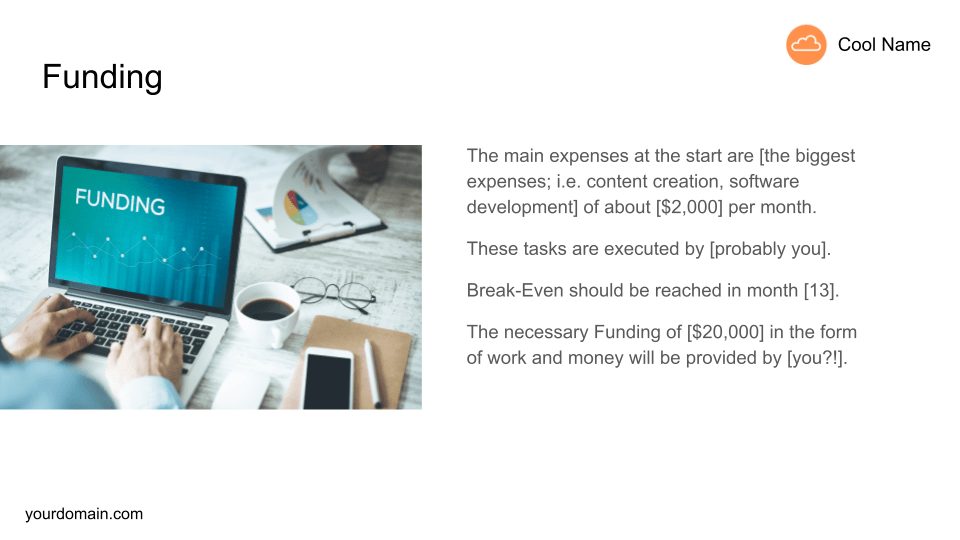
Testimonials
Every honest feedback from paying customers is priceless. If you already have reviews, this slide is the right place for them.
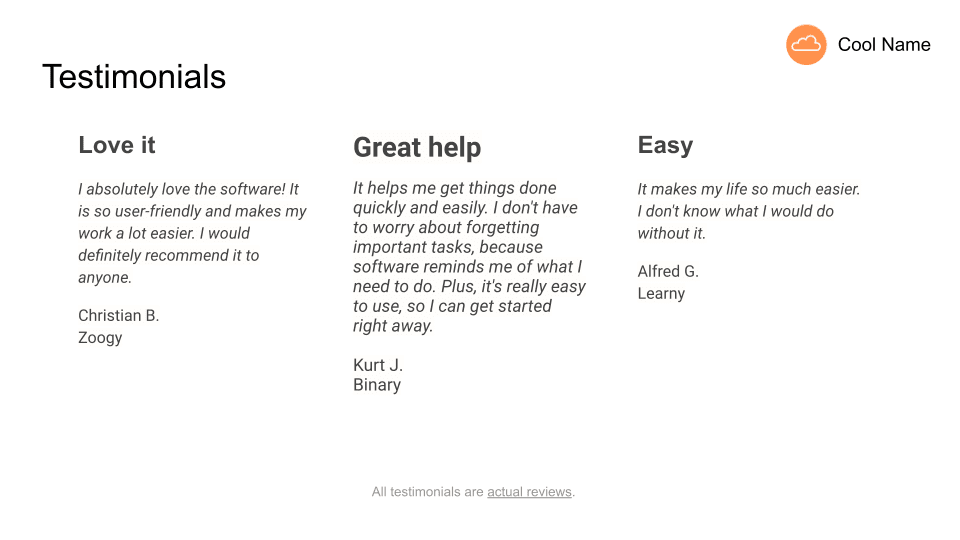
Call-to-Action
Finish your pitch deck with a compelling call-to-action. Show a preview in your pitch deck to raise interest and engage the reader. For example:
- Subscribe to our free newsletter (with a Link)
- Visit our website to download this free report about X (with a Link)
- Watch this video about X (with a Link)
- Follow me on Twitter (with a Link)

Example: My Finmods SaaS Pitch Deck
Check out my pitch deck about Finmods SaaS. As I´m a solopreneur and as I don´t need external funding, I made this pitch deck only for myself. It´s my basic business plan, that I can come back to, when I feel to get off course.
Together with my financial model, which I also made with Finmods SaaS, these tools help me to stay focused and to remember my original plan. I can´t overstress the problem of getting distracted, especially when you are a solo founder.
You learn so much every day and you want to implement as much as possible; this is great, but it also includes the danger to get off track. This is where the pitch deck and the financial model come in and help. Freshening up my thoughts just takes a few minutes from time to time and its value is priceless.
Get the Finmods Pitch Deck Template
If you like my template, you can get it here.
Your benefits:
- Starting with a good template is the easiest way to build a compelling pitch deck
- You get 18 fill-in-the-blanks slides with short explanations
- Built with Google Slides, delivered as a PowerPoint File .pptx
- Insert your data and pictures, and you are good to go!
Get Finmods SaaS
If you like my financial model, you can get it here.
Peter is a solopreneur in Salzburg, Austria, a husband, and a family father. He runs a little publishing company, and blogs about starting and running online businesses. In his spare time, he enjoys hiking with friends and reading the Bible, and sometimes he takes a trip in his roaring old black 2001 Jaguar XJ8.
